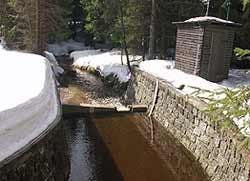Czech Republic Buys Water Quality Data and Not Just Instruments
The collection of water quality data from remote locations with difficult access represents a significant challenge. However, data from such water resources can be highly valuable in the detection of diffuse pollution.
In recent years, manufacturers of water quality monitoring instrumentation have made significant improvements to their products that have resulted in an extension of the time required between visits to installed monitors.
For example, YSI has launched a water quality monitoring sonde with an extended deployment system (EDS) that is able to monitor up to 10 parameters in high-fouling environments.
However, even with advances such as these, the collection of water quality data can represent an activity which some organizations do not have the resources to undertake.
Recent exampleIn one such example, in the Czech Republic, a local firm of water quality specialists was employed to collect data in the Jizera Mountains. The project was designed so that it was not necessary to purchase new monitoring equipment or to employ and train staff for its operation.
The Jizera Mountains represent a fragile environment; granite bedrock and peat soils make the ecosystem naturally acidic with low neutralizing capacity. As a result, it is particularly sensitive to acid rain and has suffered considerably over the last few decades. The watersheds of the Jizera Mountains are important in that they supply one fifth of the Czech Republic’s water, including that for the capital city, Prague.
Historically, prevailing winds have brought acid rain created by sulfur dioxide emissions from power industries, located both within the country and in neighboring Germany and Poland. The legacy of this pollution is believed to remain within the Jizera’s acid soils.
Forest damage took place for a number of years, particularly in the 1980s, and fish kills have been reported.
A project is now under way to monitor a catchment area within the Jizera Mountains. The project aims to monitor a wide range of environmental parameters, so that a complete picture of the ecosystem can be created.
Continuous monitoringIn the past, research work has been based on weekly sampling, at best, and this has often failed to reveal specific incidents, such as changes in water quality during ice melt. The project therefore sought to provide continuous monitoring data.
The project is part of “Project Labe IV” and the work is being performed by a private company, Vodarenska, a.s. in conjunction with the Czech Hydrometeorological Institute on behalf of the Research Water Resources Institute T.G.M. in Prague.
The project sponsor has not purchased monitoring equipment, preferring instead to simply purchase data from Vodarenska, who have been responsible for the installation, maintenance and management of the monitoring equipment.
The benefits of buying data rather than instruments are that costs are clearly established from the start—there are no issues with unnecessary equipment at the end of the project; and it is not necessary to employ technical staff to install, operate, and maintain the equipment.
Vodarenska specializes in environmental monitoring; the company already has technical staff and maintains a stock of environmental instrumentation, so it makes sense for it to take ownership of the monitoring activity.
Prior to the installation of these continuous water quality monitors, samples had been taken for subsequent laboratory analysis. However, the sampling points were remote and access was difficult so site visits were costly and problematic.
Furthermore, spot sampling did not reveal a sufficiently accurate picture of water quality, such that any diurnal trends and events occurring between sampling were missed.
For example, because the continuous monitoring sondes have been deployed, a reduction in pH from 6.2 to 4.2 has been identified during ice melt.
Vodarenska visits the sites every three weeks to check calibration and to take reference samples for laboratory analysis. The staff has been delighted with the reliability and accuracy of the sondes, not least because they now have to make the 300 km journey much less frequently.
In summary, this project raises the issue of instrumentation ownership. Essentially, owning instruments is simply a means to an end, which is the water quality data itself. In certain situations, buying data rather than equipment makes more sense for an organization, given its budget, resources, and level of technical training.
